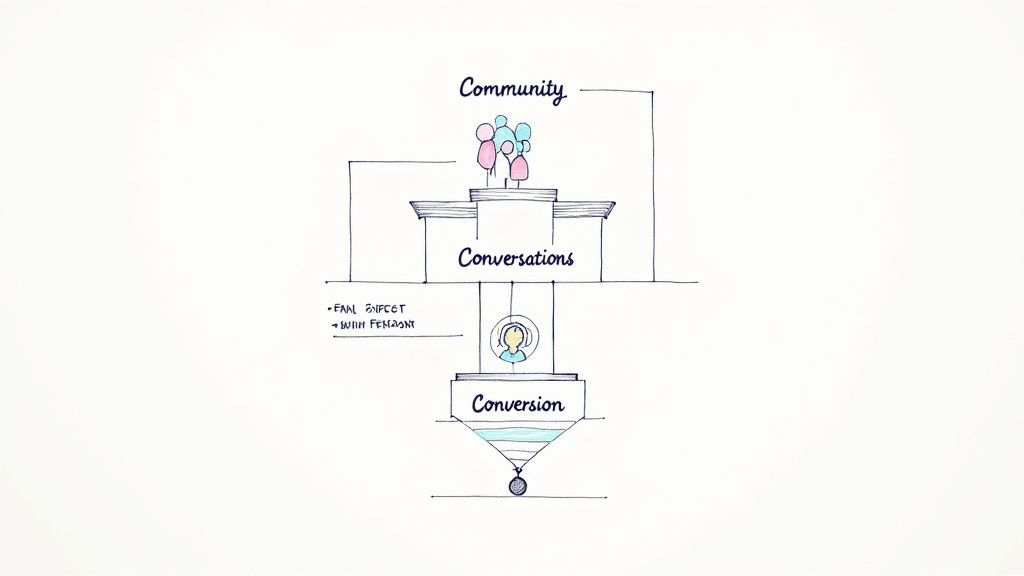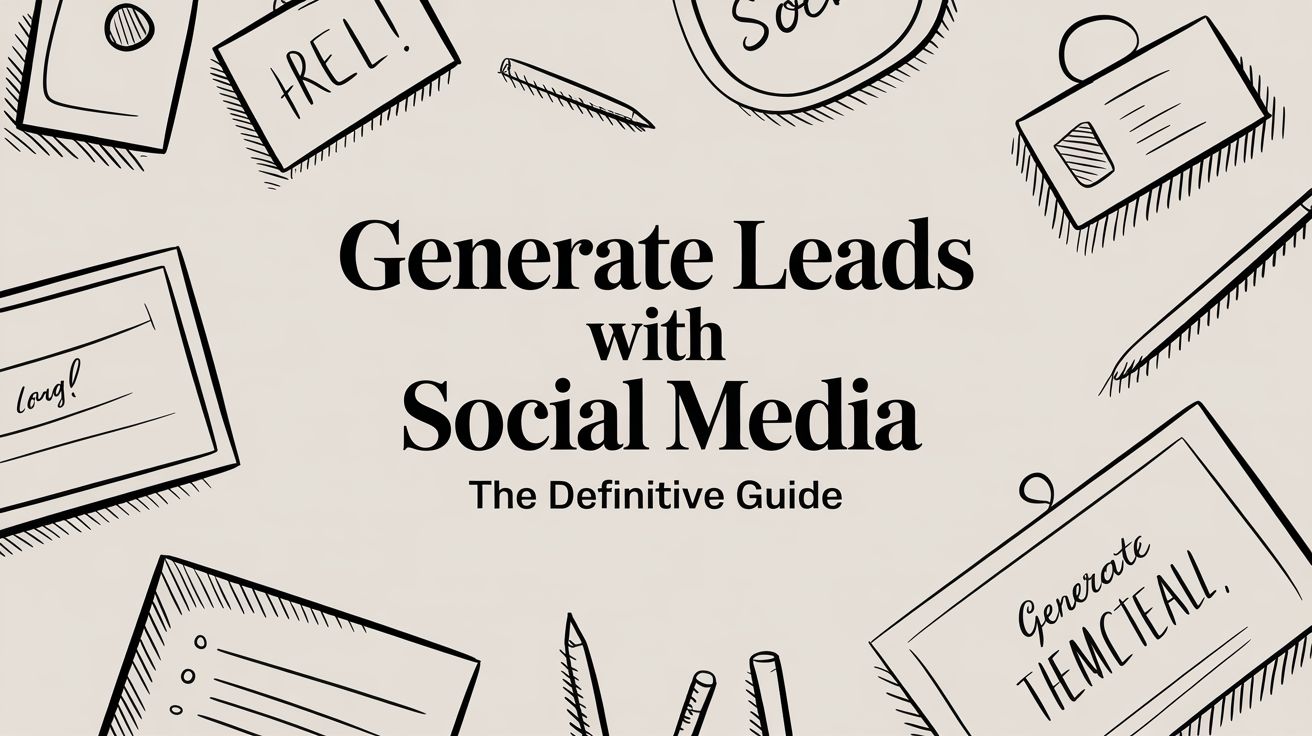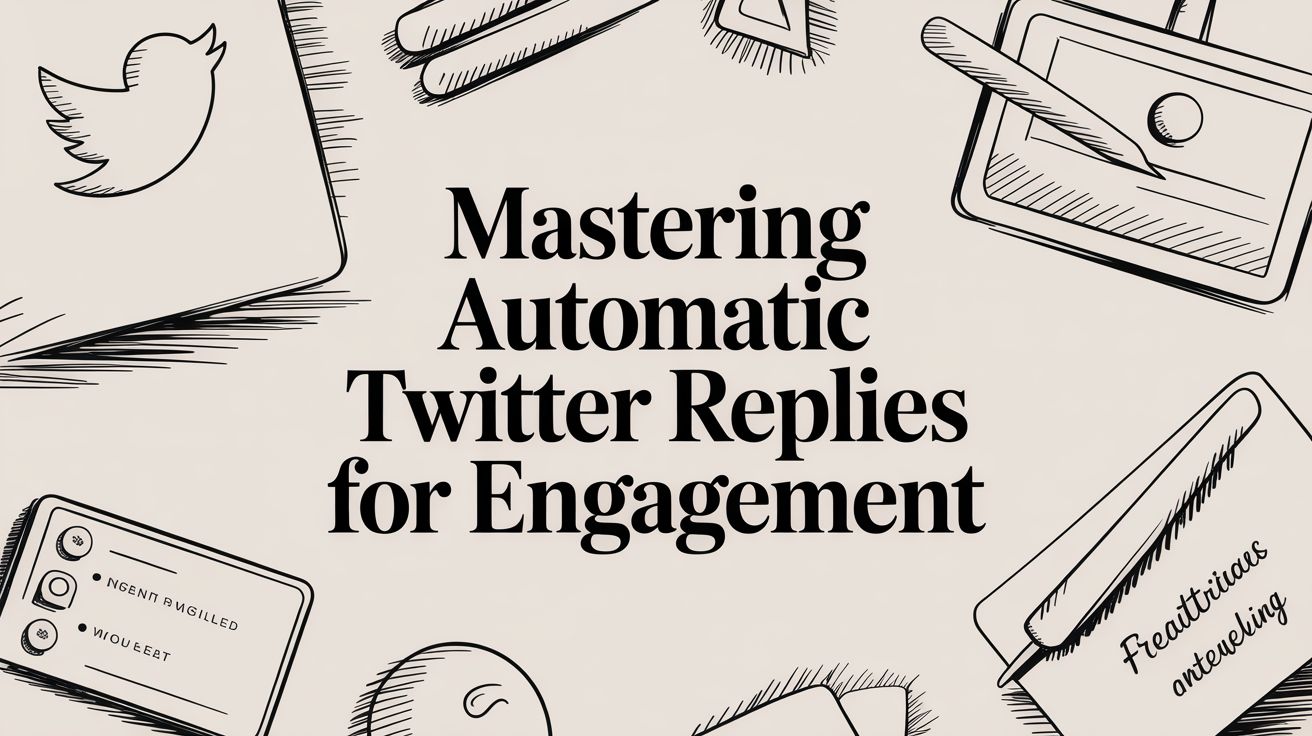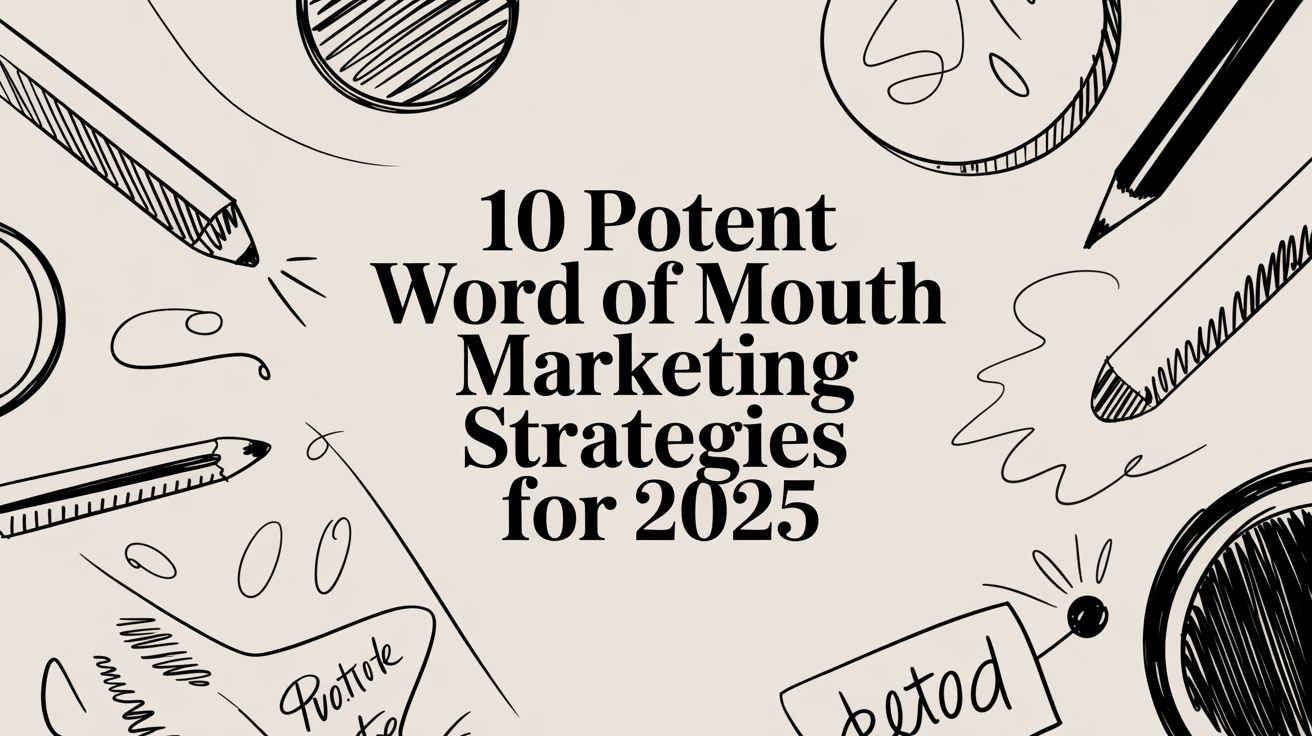Forget everything you’ve been told about just “posting more content.” If you want to generate leads with social media, you have to do more than just broadcast your message. It's about building real communities, having actual conversations, and making it dead simple for interested people to take the next step.
This guide is designed to skip the fluff and give you platform-specific strategies that actually attract high-quality leads.
Your Modern Blueprint for Social Media Leads

So many businesses fall into the trap of thinking followers and likes will magically turn into sales. But lead generation on social media isn’t an accident; it’s a system. You need a repeatable blueprint that turns casual scrollers into qualified prospects who are genuinely interested in what you offer.
This isn’t about shouting into the void. It’s about listening, being genuinely helpful, and guiding potential customers toward a solution. The numbers back this up. By 2025, 68% of marketers said social media directly helped them generate more leads. What's even more impressive? 66% of them did it by spending just six hours a week. That’s the power of a smart, focused strategy.
To get these kinds of results, you need to understand the core pillars that hold up a successful lead generation engine. Each one is critical and they all work together—get one wrong, and the whole thing can stall.
Core Pillars of Social Media Lead Generation
This table breaks down the essential components you need to build a system that consistently brings in new leads from your social channels.
| Pillar | Objective | Key Action |
|---|---|---|
| Audience Definition | Know exactly who you're talking to. | Create a detailed Ideal Customer Profile (ICP) that goes beyond demographics to include pain points, goals, and online behavior. |
| Platform Selection | Be where your customers are. | Research and choose the 1-2 platforms where your ICP actively hangs out, instead of spreading yourself too thin. |
| Value-First Content | Be a resource, not an advertisement. | Create content that solves problems, answers questions, or entertains, establishing your expertise and building trust. |
| Authentic Engagement | Build real relationships. | Join conversations, monitor keywords and hashtags, and interact with potential leads in a genuine, non-salesy way. |
| Frictionless Conversion | Make it easy for people to say "yes." | Design clear and simple paths—like lead magnets or demo requests—that guide users from a post to a lead form without any hassle. |
Think of these pillars as a flywheel. Once you get them all spinning in harmony, the momentum builds, and lead generation becomes a predictable part of your business.
The real secret is to stop acting like an advertiser and start being a resource. When you show up consistently to help people, they'll naturally think of you when they're ready to buy. That's how you build a sustainable lead machine.
To get started, you need a solid plan to convert passive scrollers into high-quality social media leads. In the next sections, we’ll break down each of these pillars with practical steps and real examples to give you a complete blueprint you can put into action right away.
Finding Your Audience and Best Platforms

Before you even think about posting, you have to nail two critical questions: who are you trying to talk to, and where are they actually spending their time online?
Trying to generate leads with social media without a crystal-clear audience is a surefire way to waste time and money. It’s like shouting into a packed stadium, just hoping the right person happens to hear you. It doesn't work.
Real success comes from digging deeper than basic demographics. You need to build a detailed Ideal Customer Profile (ICP) that feels like a real person. What keeps them up at night? What industry slang do they use? What blogs or newsletters are their go-to sources?
Answering these questions shifts your entire strategy from generic broadcasting to precision-guided communication. You'll know exactly which problems to solve with your content.
Crafting Your Ideal Customer Profile
Think of your ICP as the north star for every single thing you do on social media. It stops the guesswork and allows you to make smart, informed decisions that resonate with your target leads.
The best place to start? Talk to your best current customers. I mean, really talk to them. Ask about their day-to-day, their biggest headaches, and where they turn for industry news. Their answers are pure gold and will point you toward finding more people just like them.
From those conversations, start building out a profile that includes:
- Professional Goals: What does a "win" look like in their role? Are they chasing a promotion, trying to boost revenue, or just make their team's life easier?
- Daily Pain Points: Get specific. What are the nagging, persistent problems that your product or service is built to solve?
- Online Hangouts: Where do they really hang out? Are they in LinkedIn Groups, scrolling X (formerly Twitter) threads, or hiding out in niche subreddits?
- Content Preferences: Do they prefer quick, digestible video tutorials? Or are they the type to dive into a deep, data-driven article?
This level of detail is what separates content that gets ignored from content that your ideal customer feels was made just for them.
Matching Your ICP to the Right Platform
Once you have a solid picture of who you're looking for, figuring out where they are becomes infinitely easier. So many businesses make the mistake of trying to be everywhere at once. Don't. Focus your energy where it will actually make a difference.
Each platform has its own vibe and purpose. A B2B SaaS company aiming to connect with CTOs will find them on LinkedIn, talking shop about tech stacks and leadership. They won't find them doing dance challenges on TikTok. On the flip side, a direct-to-consumer brand can crush it on Instagram and TikTok, where visual storytelling and user-generated content are everything.
The goal isn't to be on the most popular platform; it's to be on the platform most populated by your ideal customer. A small, hyper-engaged audience on a niche platform beats a massive, indifferent one every single time.
Validating Your Platform Choice
So, how do you know you've picked the right spot? Simple. You listen.
Before you go all-in, spend a couple of weeks just lurking and monitoring conversations on your chosen platforms. You can use a variety of tools to track keywords, hashtags, and mentions relevant to your space. If you're unsure where to start, you might want to look at a social listening tools comparison to see which one fits your budget and goals.
Let's say you run a project management software company. You could track terms like "team collaboration," "missed deadlines," and "project visibility." If you see active, meaningful discussions around these topics popping up in certain LinkedIn Groups, you've hit the jackpot. If all you hear are crickets, that's a clear sign to rethink your strategy.
This validation step is non-negotiable. It keeps you from wasting months creating content for an empty room. It ensures that when you finally do jump into the conversation, you’re adding value where it’s actually wanted, setting the stage to generate leads with social media from day one.
Mastering B2B Lead Generation on LinkedIn
When it comes to B2B, let's be honest: not all social platforms are created equal. Trying to find high-quality B2B leads on most social media channels feels like fishing in a desert. LinkedIn, on the other hand, is the ocean. It's the undisputed heavyweight for connecting with decision-makers and professionals.
The numbers don't lie. Recent data shows a staggering 62% of B2B marketers name LinkedIn as their number one source for leads. That's more than double the next best channel. In fact, it's considered 277% more effective for generating leads than Facebook or X. Even better, LinkedIn's own Lead Gen Forms have a jaw-dropping 13% average conversion rate.
But success on LinkedIn isn't about just having a company page and posting the occasional update. You need a real strategy to turn your presence from a digital brochure into a powerful lead-generating engine.
Optimize Your Profile to Be a Lead Magnet
Your personal profile is your frontline. It's often the very first impression a potential lead has of you, so it needs to do more than just list your job history. It has to act as a magnet for your ideal client.
Start with your headline. Ditch the generic "CEO at Company X" and craft a value proposition that speaks directly to your prospect's biggest problem. For example, a marketing consultant could use something like, "I Help SaaS Founders Double Their MQLs Without Upping Ad Spend." This immediately qualifies you and grabs the right kind of attention.
Next, think of your "About" section as a mini-landing page. Don't just list what you do; tell a story about how you solve problems for your clients. Sprinkle in the keywords and phrases your prospects would actually use to find someone with your expertise.
Reach Out Like a Human, Not a Bot
An optimized profile is great for attracting inbound interest, but proactive outreach is how you really fill your pipeline. The secret? Avoid those generic, robotic connection requests that everyone immediately ignores.
Personalization is everything.
Before you even think about hitting "Connect," spend two minutes on the person's profile. Find a recent post they shared, a mutual connection you both trust, or a recent accomplishment they're proud of.
A simple, effective message could look like this:
"Hi [Name], I saw your recent post on [Topic] and really appreciated your insights on [Specific Point]. I'm also focused on helping [Their Industry] leaders with [Your Solution], and I'd love to connect and follow your work."
This simple approach proves you’ve done your homework and aren't just spamming for connections. If you want to dive deeper, this guide on how to get leads from LinkedIn has more advanced templates and follow-up strategies.
Tap Into Niche LinkedIn Groups
LinkedIn Groups are one of the platform’s most overlooked goldmines for leads. Think of them as virtual conference rooms packed with your ideal customers, all talking about the topics that matter to your business.
But don't just jump in and start dropping links to your website. That’s the fastest way to get yourself kicked out.
The game here is to provide genuine value. Answer questions. Share helpful resources (especially ones that aren't your own). Actively participate in discussions. When you position yourself as a trusted expert, people will naturally start checking out your profile and reaching out to you.
By becoming an active, helpful member of relevant groups, you put yourself directly in the path of prospects who are already looking for solutions.
Create Content That Starts Conversations
Your content strategy on LinkedIn should be all about starting conversations, not just collecting likes. A handy tool like a LinkedIn Post Generator can be a great starting point for brainstorming ideas that spark engagement.
Focus your posts on sharing unique insights, asking thought-provoking questions, or telling compelling stories about customer wins. Every single post is a chance to engage with potential leads in the comments section.
To close the loop and turn those conversations into conversions, use LinkedIn’s built-in tools. LinkedIn Lead Gen Forms are incredibly powerful because they pre-fill a user's contact information from their profile, which massively reduces friction and boosts conversion rates. You can link these forms directly from your ads or even add them to your company page, creating a dead-simple path for interested prospects to raise their hand.
Creating Content That Actually Converts
Let's be real: your social media feed is a war for eyeballs. If you want to win, your content can't just be nice—it has to be a finely-tuned machine designed to turn casual scrollers into real, qualified leads. This means getting past the vanity metrics like likes and shares and building a content engine that actually moves people closer to a sale.
It all boils down to understanding that different content does different jobs. Someone who’s just realizing they have a problem needs a completely different message than someone who’s actively comparing vendors. Mapping your content to their journey is how you turn fleeting engagement into tangible action.
Aligning Content with the Buyer's Journey
Think of your content as a series of breadcrumbs. Each post, video, or guide needs to lead your ideal customer down a specific path, gently guiding them from "Hmm, I have a problem" to "You are the exact solution I need."
To do this right, you need a smart mix of formats and topics for each stage of their journey:
- The "Awareness" Stage: Your job here is to attract and educate, not sell. The content should speak directly to the common pain points and nagging questions your audience has. Short-form videos, helpful blog posts, and insightful infographics are your best friends here. For example, a cybersecurity firm could post a quick video titled "3 Sneaky Security Risks Small Businesses Always Overlook" to grab the attention of founders who haven't made security a priority yet.
- The "Consideration" Stage: Okay, you've got their attention. Now it's time to build trust and show them you know your stuff. This is where you go deeper with case studies, detailed how-to guides, and webinars that showcase your unique approach. That same cybersecurity firm might host a webinar on "How to Build a Cybersecurity Action Plan in 5 Simple Steps," positioning themselves as a go-to expert.
- The "Decision" Stage: By now, they're close to making a choice. Your content needs to make it incredibly easy for them to choose you. This is the time for free trials, product demo videos, or detailed comparison sheets. Your call-to-action (CTA) should be crystal clear and lead them straight to the finish line.
When you structure your content this way, you're always delivering the right message to the right person at the right time.
Gated Content: Your Secret Weapon for Leads
If you want to generate leads with social media, you have to give people a seriously compelling reason to hand over their contact info. That's where high-value, gated assets come into play. Gated content is anything you put behind a simple form—think ebooks, whitepapers, templates, or exclusive video courses.
The trick is making the offer so valuable that the exchange feels like a steal for them. A weak "subscribe to our newsletter" CTA just isn't going to cut it anymore.
Your gated asset must solve a specific, urgent problem for your ideal customer. If it doesn't, they won't give you their email. It's that simple. The perceived value of what you're offering has to feel way higher than the "cost" of giving up their email address.
For instance, a marketing automation company could create a downloadable "SaaS Marketing Funnel Template Pack." This isn't just theory; it's a tangible tool that prospects can use immediately, making the email exchange a complete no-brainer. You can then promote this single, high-impact asset across all your social channels.
Platform Content Strategy Comparison
Not all platforms are created equal when it comes to lead generation. What works on LinkedIn will likely fall flat on Instagram. You have to tailor your content format and your call-to-action to fit the platform's culture and audience expectations.
Here’s a quick breakdown of how to approach the major players:
| Platform | Primary Audience | Top Lead Gen Content Format | Best CTA Approach |
|---|---|---|---|
| B2B Professionals, Executives | In-depth articles, whitepapers, case studies, webinars | Direct & professional. "Download our report" or "Register for the webinar." | |
| B2C Consumers, Millennials, Gen Z | High-quality visuals, carousels, Reels, interactive Stories | Softer & visual. "Link in bio for the free guide" or "Swipe up to shop." | |
| Broad B2C & Local B2B | Video ads, customer testimonials, community-building content | Community-focused. "Join our group" or "Get your exclusive offer." | |
| X (Twitter) | News Junkies, Tech & Media Pros | Quick tips, industry stats, threads, links to blog posts | Conversational & urgent. "Read the full thread" or "Grab the template here." |
By understanding these nuances, you can stop wasting time creating content that doesn't resonate and start focusing your efforts on what will actually drive leads on each specific platform.
From Pillar Content to Social Snippets
Look, creating a massive ebook or an in-depth webinar is a ton of work. The smart play is to take that one "pillar" piece of content and slice and dice it into dozens of smaller social media posts.
A single one-hour webinar can become:
- 10-15 short video clips perfect for highlighting key insights on Instagram Reels or TikTok.
- 5-7 powerful quote graphics to share on LinkedIn and X.
- A carousel post for Instagram that summarizes the main takeaways.
- A detailed blog post that expands on the webinar's core themes.
This "create once, distribute forever" strategy maximizes your reach and gives you a steady stream of content to promote your lead magnet without sounding like a broken record. Each snippet is a new hook, pulling traffic back to the same high-converting landing page.
This isn't just a nice idea; it's a proven strategy. Research shows that content marketing is set to account for a 51.5% share of all lead generation strategies by 2025. You can dig into more lead generation statistics and their impact on modern marketing to see just how critical this is. By building a system around valuable, convertible content, you create a reliable machine that turns your social media activity into real, measurable business growth.
Building Your Path from Click to Conversion
Getting someone's attention on social media is a great first step, but it's just the start. The real skill lies in guiding that initial spark of interest into a genuine lead for your business. That entire journey—from their first click on your post to the moment they hit "submit" on your form—is what we call a conversion path.
Think of it like building a bridge. On one side, you have a curious prospect scrolling through their feed. On the other, you have a qualified lead landing in your CRM. Every single element, from the ad copy and the landing page to the form itself, is a plank in that bridge. If even one piece feels weak, confusing, or out of place, your prospect will simply drop off.
This graphic really nails the journey from someone just becoming aware of you to making a final decision.

As you can see, each stage requires a different touch to move a prospect forward successfully.
Designing a High-Converting Landing Page
Your landing page has one job: convert visitors. That’s it. This isn't the place for distracting navigation menus or mixed messages. Every pixel should be focused on getting that visitor to take one specific action.
Remember, a massive chunk of your social media traffic will be on mobile devices. So, you have to design with a mobile-first mindset. If someone has to pinch and zoom just to read your text or find the form, they're gone. Simplicity and clarity are everything.
Here’s what every killer landing page needs:
- A Headline That Matches the Ad: The message that made them click your social post needs to be the very first thing they see. This instantly confirms they’re in the right place.
- A Clear Value Proposition: In a sentence or two, what’s in it for them? Be crystal clear about the benefit they get by handing over their info.
- Minimal Form Fields: Only ask for what you absolutely need. Often, a name and email are plenty. Every extra field you add is another reason for them to bail.
- A Strong Call-to-Action (CTA): Ditch the boring "Submit." Use action-oriented language on your button, like "Get My Free Guide" or "Download the Checklist."
The Art of the Follow-Up Sequence
The moment you capture a lead, the clock is ticking. You need a fast, automated follow-up to capitalize on their interest while it's still hot. This is where a smart email automation sequence becomes your best friend.
Your first email should land in their inbox almost instantly, delivering whatever you promised (like an ebook or webinar link) and offering a warm welcome. But don't just stop there. A well-planned email sequence is your chance to build a relationship and gently guide them toward a real conversation.
A lead isn't a one-time transaction; it's the beginning of a conversation. Your automated follow-up sequence is your chance to make a great first impression at scale, building trust long before you ever ask for a sale.
A simple, effective three-part sequence might look something like this:
- Immediate Delivery: The asset they requested hits their inbox right away. No delays.
- Value-Add Follow-Up (2 days later): Send a related blog post or a quick tip that helps them get even more value from the thing you just gave them.
- Soft Pitch (4 days later): Briefly introduce how your service solves the bigger problem they're facing and invite them to a no-pressure demo or call.
Measuring What Truly Matters
If you want to generate leads with social media effectively, you can't fly blind. You need to track the right metrics to see what’s actually working. Forget vanity metrics and focus on the Key Performance Indicators (KPIs) that directly impact your bottom line.
Using your platform analytics and tools like Google Analytics, you should be tracking these critical KPIs:
- Cost Per Lead (CPL): This is your north star. It tells you exactly how much it costs to acquire each new lead. The math is simple: Total Ad Spend / Total Leads = CPL.
- Conversion Rate: Of all the people who visit your landing page, what percentage actually fill out the form? This number shows you how effective your page design and offer really are.
- Lead Quality Score: Let's be honest, not all leads are created equal. Work with your sales team to define what a "qualified" lead looks like, then track how many of those you're getting from each campaign.
By keeping a close eye on these numbers, you can start making data-driven decisions that turn your social media efforts into a predictable, profitable machine for generating leads.
Scaling Your Strategy with Smart Automation
Let's be real: manually engaging on social media is incredibly effective, but it has a limit. As you start seeing real success and generate leads with social media, you'll hit a wall. How do you keep up with all the conversations without burning out your team or sacrificing the quality that got you here in the first place?
The answer isn't to replace your team with bots. It’s about being smarter with your time. You need to build a system around what’s already working, letting technology handle the repetitive stuff so your team can focus on what they do best: building relationships with qualified prospects.
Choosing Your Scaling Path
When you're ready to grow, you've got a few different ways you can go. The right choice really depends on your team's size, your budget, and what you’re trying to achieve.
- In-House with Software: This means arming your team with tools like social schedulers and monitoring platforms to make them more efficient. You keep full control, but it's still a significant time commitment from your people.
- Specialized Automation Services: This is where you bring in a partner to do the heavy lifting—finding the right conversations, filtering out the noise, and sometimes even handling the first reply. It frees up your team to jump into conversations that are already warm.
- A Hybrid Approach: You can also mix and match. Maybe your in-house team handles your main brand channels while a service takes care of broader outreach and finding new leads. This often strikes the perfect balance between control and scale.
The whole point is to automate the tedious parts, like digging for relevant posts, so your team can pour their energy into the human connections that actually close deals.
Here's a look at the kind of clarity a good dashboard provides. This one from Replymer shows how you can track your automated outreach at a glance.
A clean dashboard like this tells you instantly what’s working. You can see which keywords are hitting the mark and which platforms are driving results, all without drowning in spreadsheets.
The goal of automation isn't to remove the human element; it's to multiply its impact. By automating the discovery and initial engagement, you empower your team to have more meaningful, high-quality conversations with genuinely interested leads.
For instance, services that provide automatic Twitter replies can keep an eye on your keywords around the clock. They spot opportunities and send out authentic, human-written responses to kick off a conversation.
This shifts your whole strategy from being reactive to proactive. You stop waiting for opportunities and start creating them, building a lead generation engine that can truly grow with your business.
Answering Your Top Social Media Lead Gen Questions
Jumping into social media for lead generation always brings up a few key questions. It's totally normal. Let's walk through the big ones so you can move forward with a clear, confident plan.
"Which Social Media Platform Is Actually Best for Getting Leads?"
This is the classic question, but there's no magic bullet. The "best" platform is simply wherever your ideal customers are already hanging out and talking.
Think about it this way: for most B2B businesses, LinkedIn is a goldmine. It's where professionals go to network, learn, and discuss industry-specific challenges. If you're selling to other businesses, that’s your starting line.
On the other hand, if you're a direct-to-consumer brand with a strong visual identity, you’ll likely find your people on Instagram or even TikTok. The key isn't to be everywhere; it's to be where it counts. Go where your customers are, not where the latest trend is.
"How Much Money Should I Really Budget for Social Ads?"
Instead of picking a random number, tie your budget directly to your goals. The first thing you need to figure out is your target Cost Per Lead (CPL). What's a qualified lead worth to your business?
If you're just starting out, don't go all in. Set aside a small, experimental budget—maybe $250 to $500—and run a focused test campaign for a week or two. See what happens.
Don't view this initial spend as an expense. It’s an investment in data. You're paying to learn which ads, offers, and audiences actually work, which is invaluable information for scaling up later.
Once you have real-world data showing your CPL is, say, $15, you can build a predictable budget. Need 50 leads next month? You know you'll need to allocate at least $750 to that campaign to hit your goal.
"Is It Possible to Get Leads Without Paying for Ads?"
You bet. Generating leads organically is a different game—it's slower and more about building relationships, but the payoff is a fiercely loyal community. It’s the long game, and it works.
Your focus here should be on genuine value and community building.
- Jump into conversations: Don't just post and ghost. Find relevant groups, hop into comment threads, and actually talk to people.
- Create killer content: Give away your best stuff. Think helpful guides, templates, and insights that solve real problems for your audience.
- Optimize your profiles: Treat every social profile like a mini-landing page. Your bio, pinned posts, and links should make it incredibly easy for someone to understand what you do and where to go next.
Paid ads give you speed and scale, no doubt. But a solid organic strategy is the foundation that keeps leads coming in for years to come.
Ready to scale your social engagement without spending all day scrolling? Replymer finds the right conversations on Reddit, X, and LinkedIn and has real writers craft authentic replies to bring qualified leads directly to you. Learn how it works at replymer.com.



